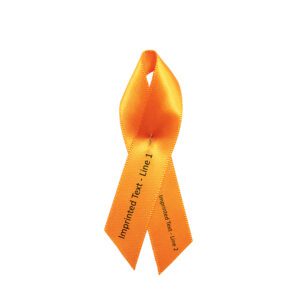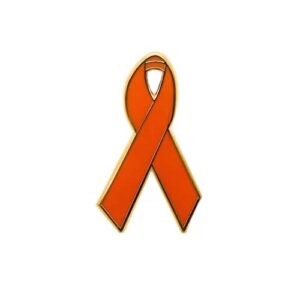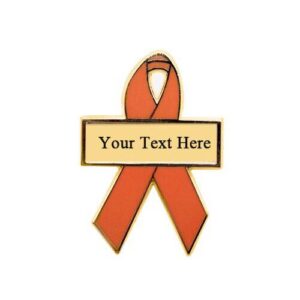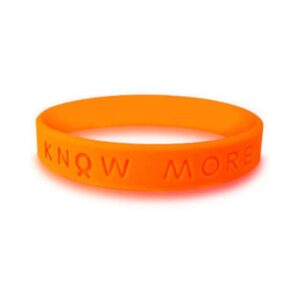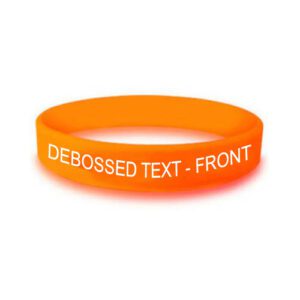Search by Color or Cause
$49.95
Wear your heart on your sleeve with an orange fabric awareness ribbon on your lapel.
Shop Personalized Cause for awareness ribbons, pins, and wristbands for over 1000 causes.
Our orange cloth fabric ribbons come in bags of 250 pieces (bulk).
Simple awareness ribbons started it all: a global movement for a better tomorrow. Today, an awareness ribbon is an iconic, worldwide symbol of hope for warriors and survivors, alike. For over twenty years, Personalized Cause has been at the forefront of the awareness ribbon movement, and strives to keep abreast of ever-changing awareness color and cause updates. Through this attention to cause awareness, Personalized Cause raises hope, encourages compassion, and highlights medical, social, mental health, autoimmune, and cancer causes. These causes are near and dear to many. Pin a ribbon to your lapel to show support for cancer research fundraisers or group marches for social change,
Personalized Cause has the most up-to-date and comprehensive awareness cause and color reference guide on the internet. Because of that, it has taken years to compile a list that is accurate and inclusive. You can find this extensive cause list under Awareness Ribbons Colors Causes and Meanings | Reference Guide. You can also use the Find Your Product search tool on the Home Page to find the product you’re looking for – search by color or cause.
Grosgrain ribbons primarily contain cotton, polyester and fiber blends. Satin ribbons, on the other hand, primarily contain nylon or polyester. Grosgrain ribbons also have thick horizontal fibers, whereas satin ribbons are smooth to the touch. Satin ribbons are much softer than grosgrain ribbons. Many people love satin ribbons for their beautiful shiny finish, allowing them to create a sleek look.
Double-faced satin ribbon is perhaps the most common type of satin ribbon available. Like the name suggests, this ribbon has two right sides. Therefore, it doesn’t matter what side faces upward or outward, as both of the sides look the same. The alternative is a single faced ribbon, which has a shiny outer side and a muted underside. Our satin ribbons are double-faced.
We offer these orange fabric awareness ribbons in bags of 250 pieces. Our ribbons are perfect for fundraising, awareness events, cancer races, awareness campaigns, support groups, school fundraisers, funerals, memorial gifts, and promotional products. Wearing awareness ribbons sends a subtle message that you support a cause. For example, it might mean you are raising awareness for a particular social cause. Another reason to wear a ribbon is to support a medical or mental health cause. Further, perhaps the ribbon represents a cause that personally connects to a cause affecting animals. Again, the ribbon sits on the left side of the chest or over the heart which is symbolic for a cause that is heartfelt.
Please note: We cannot personalize these ribbons. However, click here to see our personalized fabric ribbons in similar colors with an attached safety pin on the back of the fabric ribbon.
Orange Awareness Ribbons – Causes, Colors, Meanings and Months:
The primary causes associated with orange awareness ribbons are Pain, Hunger and Gun Violence.
Pain
One primary cause associated with orange awareness ribbons is pain caused by certain conditions. Pain is defined as an unpleasant sensory and emotional experience associated with actual or potential tissue damage, acting as a warning mechanism to protect the body by signaling a threat or potential harm.
Pain causes may include:
Chronic Pain (alternate color: Purple)
Complex Regional Pain Syndrome
Limb Loss
Reflex Sympathetic Dystrophy Syndrome
Hunger and Food Insecurity
A person is food insecure when they lack regular access to enough safe and nutritious food for normal growth and development and an active and healthy life.
Hunger and Food Insecurity causes may include:
Food Insecurity
Hunger
Malnutrition
World Hunger
Gun Violence
About eight-in-ten murders in the United States in 2021 – 20,958 out of 26,031, or 81% – involved a firearm. That marked the highest percentage since at least 1968, the earliest year for which the CDC has online records. More than half of all suicides in 2021 – 26,328 out of 48,183, or 55% – also involved a gun, the highest percentage since 2001.
Gun control causes may include:
Gun Control
Gun Violence Prevention
Mass Shootings Prevention
School Shootings Prevention
Wear Orange Campaign
Other Orange Ribbon Causes Include:
ADHD
Agent Orange
Bullying Prevention (alternate color: Blue)
COPD (Chronic Obstructive Pulmonary Disease)
Cultural Diversity
End Violence Against Women (alternate color: White)
Familial Mediterranean Fever
Functional Neurological Disorders
Kidney Cancer
Leukemia
Limb Difference
Motorcycle Safety
MS
Multiple Sclerosis
Non-Melanoma Skin Cancer
Orange Ribbon for At Risk Animals (Animal Guardian Ribbon®)
Prevention of Cruelty to Animals (alternate color: Paw Prints)
Renal Cancer
Self Harm
Self-Injury
Wilms Tumor (also known as Nephroblastoma)
Awareness Months for Orange Causes
ADHD Awareness Month – October
Agent Orange Awareness Month – October
Chronic Pain Awareness Month – September
Complex Regional Pain Syndrome Awareness Month – November
COPD Awareness Month – November
Cultural Diversity Awareness Month – April
Familial Mediterranean Fever Awareness Month – April
Food Insecurity Awareness Month – November
Functional Neurological Disorders – April
Gun Control Awareness Month – June
Gun Violence Prevention Month – June
Humane Treatment of Animals Awareness Month – April
Hunger Action Day – September 10
Hunger Action Month – September
International Day for the Elimination of Violence Against Women – November 25
Kidney Cancer Awareness Month – March
Leukemia Awareness Month – September
Limb Difference Awareness Month – April
Limb Loss Awareness Month – April
Motorcycle Safety Awareness Month – May
Multiple Sclerosis (MS) Awareness Month – March
National Bullying Prevention Month – October
National Gun Violence Awareness Day – First Friday in June
National Hunger Awareness Day – June 6
Non-Melanoma Skin Cancer Awareness Month – May
Renal Cancer Awareness Month – March
Reflex Sympathetic Dystrophy Syndrome Awareness Month – November
Self Harm Awareness Month – March
Self-Injury Awareness Month – March
Wear Orange Weekend – June
Wilms Tumor Awareness Month – March
World Auto-inflammatory Awareness Month – April
World Hunger Awareness Month – September
WHAT IS THE HISTORY OF THE AWARENESS RIBBON?
In 1979, Penney Laingen’s husband was held prisoner during the Iran hostage crisis. To call attention to this, she placed yellow ribbons on trees in her neighborhood. She also created yellow ribbons for people to wear to show support for her husband and others being held hostage. This was the first time an awareness ribbon was used publicly as a way to silently voice support.
About ten years later, the group Visual AIDS used a bright red ribbon to represent awareness and support for AIDS and the lives lost to it. This trend caught on quickly. Awareness ribbons were so well accepted as a way to demonstrate support, in fact, that the New York Times declared 1992 as The Year of the Ribbon.
That was the same year the pink ribbon became associated with breast cancer. The Susan G. Komen Breast Cancer Foundation (now Susan G. Komen for the Cure) handed out pink hats to breast cancer survivors who participated in their Race for the Cure. Soon after, in 1992, Komen distributed pink ribbons to everyone who participated in the race.
The next big step came later that year. Alexandra Penney, editor of Self Magazine, produced their second annual Breast Cancer Awareness Month issue. This issue was inspired by Evelyn Lauder, Vice President of Estee Lauder. She was also a breast cancer survivor. Alexandra and Evelyn collaborated to create a pink ribbon to distribute in cosmetic stores throughout New York City. This action was so popular that eventually the pink ribbons were placed on cosmetics counters all across the United States during Breast Cancer Awareness Month.
That year, 1.5 million ribbons were distributed. On each one was a card that explained how to do self breast exams. They also collected over 200,000 petitions, asking the White House to provide additional funding for breast cancer research.
The next year, in 1993, popularity grew. Avon joined in the fight for breast cancer awareness and launched a pink rhinestone brooch in the shape of the pink awareness ribbon. In two years, sales from the pin raised over $10 million for breast cancer research. This visibility helped make everyone more aware of the need for research.
Many people believe that because of these awareness ribbons and the visibility they created, federal funding for breast cancer research increased from approximately $100 million in 1991 to over $550 million in 1996. This helped pave the way for pink ribbons and other colors, calling attention to the need for research money for causes such as autism, epilepsy, Alzheimer’s and many more.
Calling attention to various diseases and disorders, as well as social causes, is the impetuous behind awareness ribbons. Showing support and understanding can often make all the difference to those who struggle.
